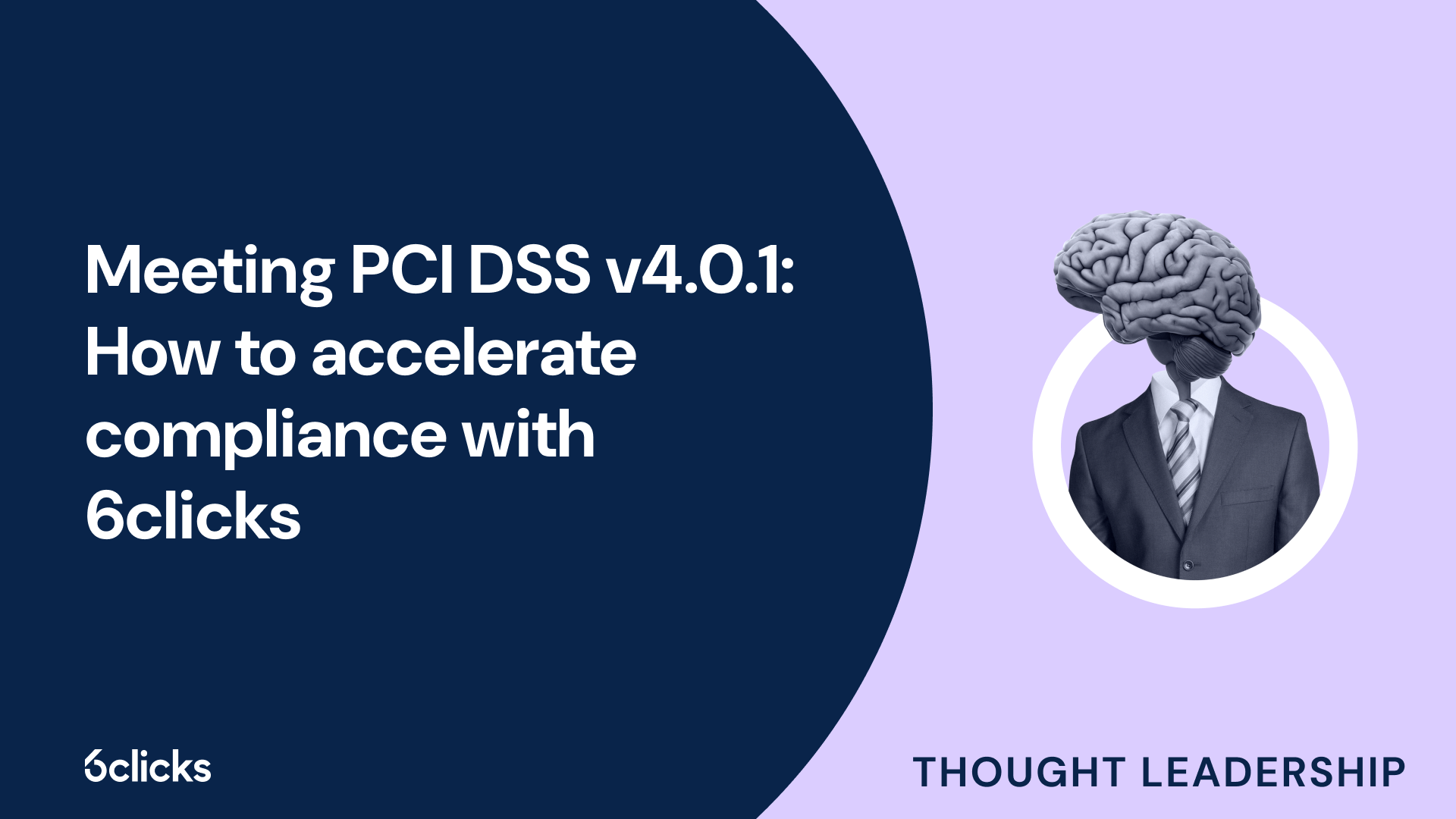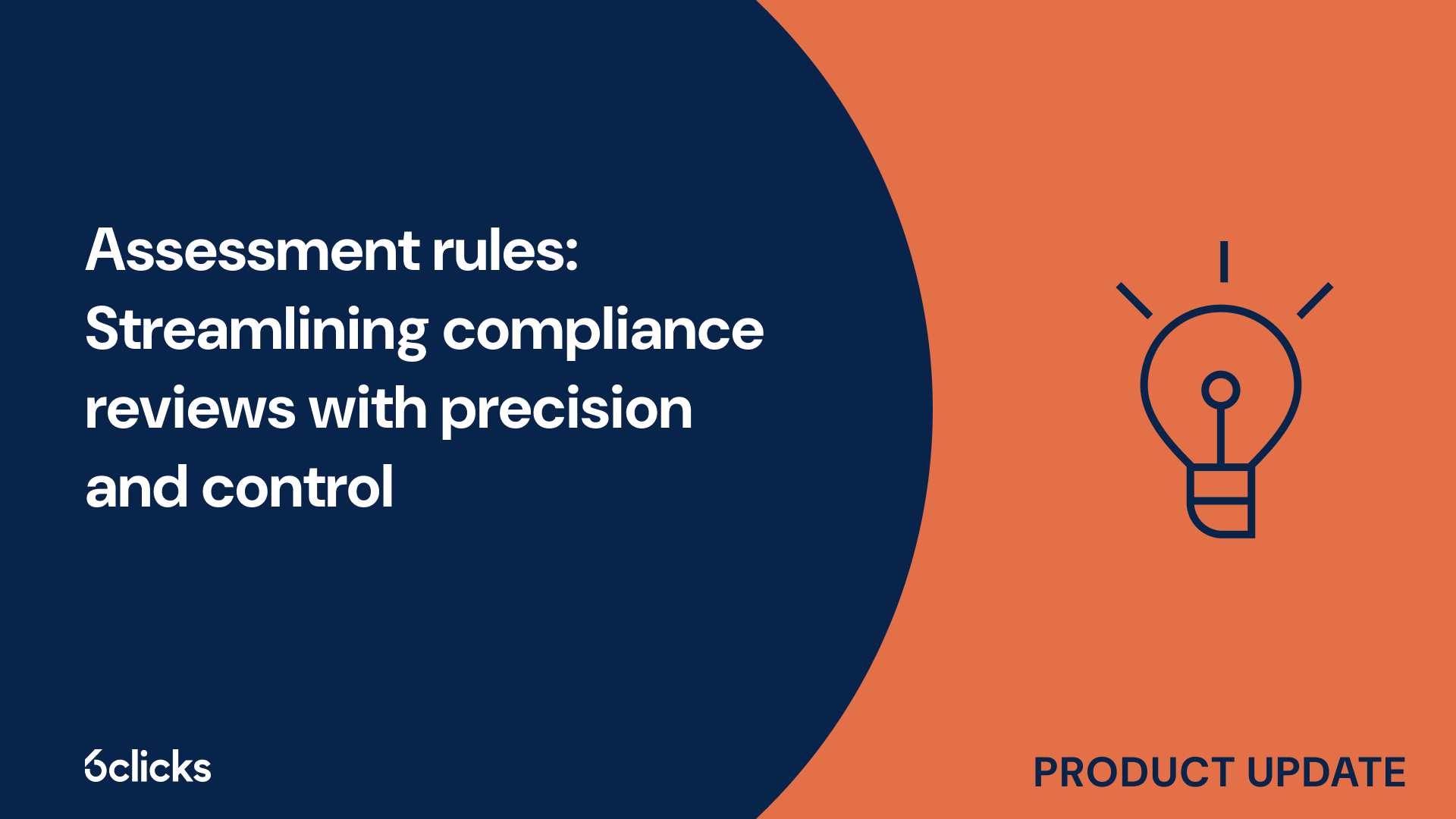The GRC buyer’s guide for 2025: Building resilience with AI-powered, federated solutions
Discover the ultimate GRC buyer's guide for 2025! Uncover how AI-powered, federated solutions transform compliance and security management for industries like government, aerospace, banking, and more. Learn about centralized control, continuous compliance, and advanced cyber GRC capabilities. Download now!
-1.png?width=200&height=249&name=Group%20193%20(1)-1.png)
The GRC buyer’s guide for 2025: Building resilience with AI-powered, federated solutions
What is ISO 27001?
ISO 27001 is an international standard for security management, outlining the requirements for implementing a comprehensive set of security controls and policies within an organization. It is designed to provide a systematic approach to managing information security risks and protecting valuable assets, including intellectual property and customer data. ISO 27001 is widely recognized as the gold standard in the field of information security and is often used as a competitive advantage by organizations to demonstrate their commitment to protecting against security threats. The certification process involves external audits by a certification body to ensure compliance with the standard's requirements. By implementing ISO 27001, organizations can establish a strong security posture, mitigate security risks, and enhance their ability to prevent and respond to security incidents. This not only helps to safeguard sensitive information and prevent unauthorized access or cyber attacks but also demonstrates a commitment to maintaining the highest level of security standards, which can be a crucial factor in winning customer trust and gaining a competitive edge in the market.
What does ISO 27001 cover?
ISO 27001 is an international standard that focuses on the establishment, implementation, maintenance, and continual improvement of an information security management system (ISMS). This standard provides a systematic approach to managing sensitive company information and ensuring its confidentiality, integrity, and availability.
ISO 27001 covers a wide range of security domains and controls that organizations should consider when implementing their ISMS. These domains include information security policies, organization of information security, human resource security, asset management, access control, cryptography, physical and environmental security, operations security, communications security, system acquisition, development and maintenance, supplier relationships, information security incident management, information security aspects of business continuity management, and compliance.
The annex of ISO 27001 details 114 controls that organizations can choose from based on their specific security requirements and risk assessment. These controls cover various aspects of information security, such as risk assessment, access control, security incident management, business continuity, and more.
By implementing ISO 27001 and adhering to its security domains and controls, organizations can enhance their information security posture, mitigate security risks, and ensure the protection of valuable assets. Additionally, ISO 27001 certification provides a competitive advantage, as it demonstrates to customers and stakeholders that the organization has implemented effective security measures and practices.
Why is ISO 27001 important?
ISO 27001 is an international standard that is crucial in today's digitally interconnected world. It plays a vital role in ensuring the security of information and protecting valuable assets within organizations.
With the constant rise in cyber attacks and security threats, it has become imperative for businesses to implement robust information security measures. ISO 27001 provides a comprehensive framework for effectively managing risks and establishing appropriate security controls to safeguard sensitive data and information.
By following ISO 27001, organizations can identify and assess potential risks, allowing them to prioritize their security efforts. The standard offers a systematic approach to risk management by providing guidelines for conducting risk assessments and implementing adequate security measures to mitigate identified risks.
Furthermore, ISO 27001 helps organizations achieve compliance with various legal, regulatory, and contractual requirements related to information security. Adhering to this internationally recognized standard enhances trustworthiness, not only among customers and partners but also in the market. It offers a competitive edge, as ISO 27001 certification demonstrates an organization's commitment to maintaining the highest standards of information security.
Benefits of implementing ISO 27001
Implementing ISO 27001 offers numerous benefits to organizations in terms of information security. Firstly, it helps businesses identify and prioritize potential security risks, allowing them to allocate resources effectively and focus on protecting their most valuable assets. By following the systematic approach provided by ISO 27001, organizations can assess risks, implement security measures, and continuously monitor and improve their security posture. ISO 27001 also helps businesses achieve compliance with legal, regulatory, and contractual requirements related to information security. This not only ensures the organization's operations are aligned with industry standards but also enhances trust and confidence among customers and partners. Additionally, ISO 27001 certification provides a competitive advantage, as it demonstrates an organization's commitment to robust information security practices. This can lead to a stronger market presence and a higher level of trust from clients, which can ultimately result in increased business opportunities. In summary, implementing ISO 27001 brings benefits such as improved risk management, compliance with regulations, and a competitive edge in the market.
Improved security practices
Implementing ISO 27001 plays a crucial role in improving security practices for organizations. ISO 27001 is an international standard that sets out the requirements for establishing, implementing, maintaining, and continually improving an information security management system (ISMS).
By adhering to ISO 27001, organizations can identify and address security flaws within their information security systems. This standard provides a systematic approach to managing and reducing vulnerabilities, ensuring that all necessary security controls and policies are established, implemented, and monitored.
Implementing ISO 27001 also helps organizations establish a baseline for handling data securely. This increases trust between organizations and their customers, as it demonstrates a commitment to protecting valuable assets and information from unauthorized access, cyber attacks, and other security threats.
Furthermore, ISO 27001 ensures a proactive approach towards risk management. By conducting regular risk assessments and internal audits, organizations can identify potential security incidents and take the necessary measures to prevent or mitigate them.
Enhanced customer trust
Implementing ISO 27001 enhances customer trust by showcasing an organization's dedication to information security. This international standard provides a comprehensive framework for establishing, implementing, and maintaining an effective information security management system. By adhering to ISO 27001, organizations demonstrate their commitment to protecting sensitive customer data and ensuring the confidentiality, integrity, and availability of information.
ISO 27001 covers every aspect of information security, including risk assessment, security controls, policies, and incident management. This thoroughness gives customers more confidence in an organization's ability to handle their information securely. By implementing ISO 27001, organizations go through a systematic approach to identify and address security risks, ensuring that appropriate controls are in place to mitigate threats.
Customers are increasingly concerned about the security of their data and want reassurance that their information will be handled responsibly. By obtaining ISO 27001 certification, organizations can provide that reassurance by demonstrating their adherence to international best practices in information security. This enhances customer trust, gives the organization a competitive edge, and establishes a solid foundation for mutually beneficial partnerships.
In today's digital landscape, trust is a valuable currency. Implementing ISO 27001 showcases an organization's dedication to information security, enhancing customer trust and confidence in the organization's ability to protect their sensitive data.
Competitive advantage in the marketplace
Implementing ISO 27001 provides organizations with a competitive advantage in the marketplace. ISO 27001 is widely recognized as the international standard for information security management systems. By achieving ISO 27001 certification, organizations demonstrate their commitment to implementing robust security controls, policies, and practices. This certification sets them apart from competitors and builds trust with customers.
ISO 27001 certification is known as the 'Golden Standard' of information security because it implies that an organization has met rigorous requirements and undergone thorough audits by an accredited certification body. This distinguishes them as a trusted and reliable partner for handling sensitive information.
The competitive advantage gained through ISO 27001 certification is multifaceted. Firstly, it enables organizations to effectively mitigate security risks and protect valuable assets such as intellectual property. This minimizes the potential for unauthorized access, cyber attacks, and security incidents, reducing the likelihood of reputational damage.
Secondly, ISO 27001 certification helps organizations comply with legal and contractual obligations related to information security. Many industries require compliance with specific security standards, and ISO 27001 provides a comprehensive framework to fulfill these requirements. This gives organizations a competitive edge by demonstrating their commitment to risk management and security best practices.
Additionally, ISO 27001 certification opens doors to new markets. Many potential clients and partners prioritize information security when choosing their business collaborators. By holding ISO 27001 certification, organizations increase their chances of securing valuable partnerships and expanding their customer base.
Improved regulatory compliance and risk management
ISO 27001 plays a crucial role in improving regulatory compliance and risk management for organizations. By implementing this international standard, organizations adopt a systematic and holistic approach to information security.
One of the key aspects of ISO 27001 is its risk-based approach to compliance. This approach involves identifying and prioritizing security risks based on their potential impact and likelihood of occurrence. By focusing on the most significant risks, organizations can allocate their resources and efforts effectively to mitigate these risks first. This ensures that security controls and measures are tailored to address the specific vulnerabilities and threats that pose the highest risks to the organization.
Additionally, ISO 27001 emphasizes the concept of continuous assessment and management of risk. Compliance is not a one-time achievement but an ongoing process. Organizations are required to regularly review and update their risk assessments, security controls, and security policies to adapt to evolving threats and vulnerabilities. This continuous monitoring and improvement enable organizations to maintain a strong security posture and stay ahead of emerging risks.
By implementing ISO 27001, organizations can improve their regulatory compliance by aligning with industry best practices and meeting legal and contractual requirements. This not only helps organizations avoid non-compliance penalties but also enhances their reputation as trustworthy and reliable partners in handling sensitive information.
Increased efficiency in processes and operations
Implementing ISO 27001 can significantly increase efficiency in processes and operations within an organization. This international standard for information security management systems provides guidelines and requirements that help streamline workflows and enhance productivity.
The standardized processes and documented operating procedures required by ISO 27001 improve workflow by providing clear and consistent instructions for employees to follow. This minimizes confusion and ensures that tasks are completed accurately and efficiently. By establishing a systematic approach to security management, organizations can eliminate redundant and time-consuming processes, resulting in streamlined operations.
ISO 27001 covers various areas that directly contribute to increased efficiency. For example, change and capacity management guidelines help organizations manage and implement changes to their information systems effectively. This ensures that system upgrades or modifications are carried out smoothly, minimizing disruptions to operations. Similarly, the development and testing guidelines promote efficient software development practices by emphasizing the importance of thorough testing and quality assurance processes.
Operational environments are also addressed, ensuring that the necessary controls, such as access control and physical security measures, are in place to protect information assets. These measures not only enhance security but also optimize operations by reducing the risk of unauthorized access or disruptions.
ISO 27001 guidelines also include controls against malware, which help organizations proactively defend their systems against cyber threats. Implementing effective antivirus software, conducting regular threat assessments, and establishing incident response procedures all contribute to maintaining operational efficiency by minimizing the impact of security incidents.
Lastly, ISO 27001 stresses the importance of information backup and disaster recovery planning. By having robust backup systems and procedures in place, organizations can quickly recover from unexpected events and reduce downtime. This contributes to increased efficiency by ensuring the continuity of operations and minimizing the loss of valuable data.
Overview of the standard's requirements
ISO 27001 is an international standard that provides guidelines for establishing, implementing, maintaining, and continually improving an Information Security Management System (ISMS). The standard sets out specific requirements for organizations to follow in order to effectively manage and protect their information assets. These requirements include conducting risk assessments, implementing security controls, developing security policies and procedures, conducting regular internal audits, and ensuring ongoing compliance with applicable laws and regulations. By adhering to these requirements, organizations can enhance their security posture, mitigate security risks, and demonstrate their commitment to protecting sensitive information. Implementing ISO 27001 not only helps organizations meet regulatory and contractual requirements but also provides a competitive advantage by instilling trust and confidence in customers, stakeholders, and partners.
Security policy framework
ISO 27001 is an international standard for establishing a security policy framework that effectively manages information security within an organization. This framework provides guidelines and procedures to ensure the confidentiality, integrity, and availability of information assets.
At its core, ISO 27001 outlines the organization's commitment to information security and serves as a foundation for establishing security controls and policies. This framework helps organizations identify and assess security risks, implement effective security measures, and continuously improve their security posture.
The security policy framework established by ISO 27001 includes several key components. First, it emphasizes the importance of top management commitment and the establishment of information security objectives. This ensures that information security is engrained in the organization's culture and strategic goals.
Additionally, ISO 27001 defines roles and responsibilities for information security management within the organization. This clarifies who is responsible for implementing and maintaining security controls, conducting risk assessments, and responding to security incidents.
Furthermore, the framework requires organizations to conduct regular risk assessments to identify potential vulnerabilities and threats. This allows organizations to take proactive measures and implement controls to mitigate risks and prevent security incidents.
By following the security policy framework defined by ISO 27001, organizations can establish a systematic approach to information security management. This not only helps protect valuable assets, such as intellectual property, from unauthorized access and cyber attacks but also provides a competitive advantage by demonstrating a robust security posture. Furthermore, ISO 27001 certification, awarded by an accredited certification body, signifies that an organization has met the stringent security requirements and has implemented an effective security management system. This certification can enhance an organization's reputation, build customer trust, and open doors to new business opportunities.
Organization of information security
The organization of information security is a key component of ISO 27001, an international standard that outlines the requirements for establishing, implementing, maintaining, and continually improving an information security management system. At its core, ISO 27001 aims to preserve the confidentiality, integrity, and availability of information within an organization.
To achieve this, the organization of information security involves implementing controls and measures that effectively manage information security risks. These controls and measures cover various aspects, such as physical security, access controls, network security, incident management, and business continuity management.
Confidentiality is maintained by implementing measures to ensure that sensitive information is protected from unauthorized access and disclosure. Integrity is preserved by putting in place measures to prevent unauthorized modifications or tampering of information. Availability of information is ensured through controls that protect against service disruptions and ensure timely access to information when needed.
By following ISO 27001 requirements and implementing a robust information security management system, organizations can establish a structured approach to managing information security risks. This not only safeguards sensitive information but also helps maintain trust with customers, partners, and stakeholders. Additionally, organizations that comply with ISO 27001 requirements demonstrate their commitment to information security, giving them a competitive edge in the market.
Asset management
Asset management plays a crucial role in achieving ISO 27001 compliance. It refers to the systematic identification, inventory, classification, and protection of an organization's information assets. By effectively managing these assets, organizations can mitigate security risks, protect sensitive information, and ensure the continuity of their operations.
To begin with, organizations need to conduct a comprehensive inventory of their information assets. This includes both physical assets, such as servers, computers, and storage devices, as well as digital assets, like databases, software applications, and networks. Additionally, intangible assets, such as intellectual property, trade secrets, and customer information, also need to be considered.
Once the inventory is complete, assets must be classified based on their importance and sensitivity. This classification enables organizations to allocate appropriate resources for their protection. Typically, assets are categorized as low, medium, or high based on the level of confidentiality, integrity, and availability required.
Asset owners play a crucial role in ensuring the protection of these assets. They are responsible for defining and implementing security controls, monitoring asset usage, and reporting any security incidents or breaches. Additionally, asset owners should regularly review and update the asset inventory to account for changes in technology, business requirements, or regulatory obligations.
Human resources security
Human resources security plays a crucial role in ensuring the effectiveness of an information security management system (ISMS) based on ISO 27001. This aspect focuses on the protection of an organization's information assets by addressing the human aspects of security. By defining roles and responsibilities, conducting background checks, and providing security awareness training, organizations can minimize the risk of internal threats and enhance the overall security posture of their systems.
Defining clear roles and responsibilities is essential in establishing accountability and ensuring that employees understand their responsibilities regarding information security. This includes identifying individuals who have access to sensitive data, defining their access privileges, and outlining their duties in protecting and handling this information appropriately.
Employee background checks are an important step in the recruitment and onboarding process. By thoroughly vetting potential employees, organizations can identify any red flags that may pose a risk to information security. These checks can include verifying qualifications, employment history, criminal records, and credit checks, where applicable.
Security awareness training focuses on educating employees about their roles in safeguarding information assets and the potential risks associated with their actions. This training covers topics such as password security, phishing awareness, physical security, and incident reporting procedures. By raising employees' awareness of these risks and best practices, organizations can create a culture of security and reduce the likelihood of security incidents.
Physical and environmental security
Physical and environmental security play a crucial role in achieving ISO 27001 certification and are crucial components of an effective security management system. These measures are designed to protect an organization's valuable assets, prevent security threats, and ultimately improve overall security awareness.
One of the primary objectives of physical security is to safeguard an organization's physical assets, such as data centers, server rooms, and sensitive documents. Physical security measures include access controls, surveillance systems, alarms, and security guards to prevent unauthorized access or breaches. By implementing these measures, organizations can significantly reduce the risk of physical intrusion and ensure the confidentiality, integrity, and availability of their sensitive information.
Environmental security, on the other hand, focuses on mitigating risks associated with natural disasters, power outages, and other environmental factors that can impact the organization's information systems and data. This can include measures like fire suppression systems, backup power supplies, and data backups at off-site locations. By implementing these measures, organizations can minimize the potential damage caused by environmental incidents and ensure business continuity.
ISO 27001:2022 has introduced specific security clauses that address both physical and environmental security. These clauses require organizations to identify and assess the risks associated with physical and environmental threats, implement appropriate security measures, and regularly review and test these measures to ensure their effectiveness.
By prioritizing physical and environmental security, organizations can protect their reputation, prevent security threats, and enhance overall security awareness. ISO 27001 certification provides a framework that helps organizations establish and maintain robust physical and environmental security measures, contributing to a comprehensive security management system.







